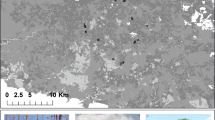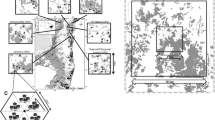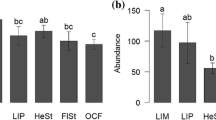Abstract
Global initiatives to reforest degraded areas have intensified in recent years, arising from advances in agricultural frontiers that mainly alter natural landscapes and suppress vegetation. However, little is known about the influence of agricultural landscapes on the re-establishment of groups that perform key ecosystem services in restoration areas, such as pollination and pest control. Using trap nest methodology, we aimed to evaluate how aspects of the landscape influence the abundance, richness, diversity, and composition of trap-nesting bees and wasps as well as their natural enemies in restored areas located within highly managed landscapes. Samplings were conducted monthly from August 2018 to August 2019 in nine reforested areas of Seasonal Semideciduous forest older than 15 years. We found evidence of a negative influence of monoculture area (i.e., surrounding soybean/corn agriculture) on the abundance of wasps and their natural enemies, indicating a preference for more heterogeneous landscapes, possibly related to the greater availability of prey and lesser edge effect in this type of landscape. Bee diversity indicates a negative relationship with increasing distance from the edge of reforestation to the edges of the nearest forest fragment. Our results also suggest that some bee and wasp species are more affected by habitat loss than other species in general, which was indicated by a change in community composition. We conclude that the nesting of solitary bees and wasps in reforested areas was influenced by characteristics of the surrounding landscape, which should be considered in restoration projects to maximize the effectiveness of ecological services such as pollination and predation.





Similar content being viewed by others
References
Aguiar CML, Zanella FCV (2005) The bee community (Hymenoptera: Apoidea: Apiformis) of an area in the border of the caatinga domain (Itatim, BA—Brazil). Neotrop Entomol 34:15–24
Akaike H (1974) A new look at the statistical model identification. IEEE Trans Automat Contr 19:716–723. https://doi.org/10.1109/TAC.1974.1100705
Araújo GJ, Monteiro GF, Messias MCTB, Antonini Y (2018a) Restore it, and they will come: trap-nesting bee and wasp communities (Hymenoptera: Aculeata) are recovered by restoration of riparian forests. J Insect Conserv 22:245–256. https://doi.org/10.1007/s10841-018-0058-8
Araújo GJ, Fagundes R, Antonini Y (2018b) Trap-nesting Hymenoptera and their network with parasites in recovered riparian forests Brazil. Neotrop Entomol 47:26–36. https://doi.org/10.1007/s13744-017-0504-4
Araújo GJ, Stork-Tonon D, Izzo TJ (2020) Temporal stability of cavity-nesting bee and wasp communities in different types of reforestation in southeastern Amazonia. Restor Ecol 28:1528–1540. https://doi.org/10.1111/rec.13250
Ascher JS, Pickering J (2021) Discover life bee species guide and world checklist (Hymenoptera: Apoidea: Anthophila). http://www.discoverlife.org/mp/20q?guide=Apoidea_species. Accessed 27 Aug 2021
Baldock K (2020) Opportunites and threats for pollinator conservation in global towns and cities. Curr Opin Insect Sci 38:63–71. https://doi.org/10.1016/j.cois.2020.01.006
Bartón K (2016) Mumin: multi-model inference. R package version 1.10.6. https://cran.R-project.Org/package=mumin. Accessed 20 Oct 2021
Bender DJ, Tischendorf L, Fahrig L (2003) Using patch isolation metrics to predict animal movement in binary landscapes. Landsc Ecol 18:17–39. https://doi.org/10.1023/A:1022937226820
Borges FLG, Oliveira MR, Almeida TC, Majer JD, Garcia LC (2021) Terrestrial invertebrates as bioindicators in restoration ecology: a global bibliometric survey. Ecol Indic 125:107458. https://doi.org/10.1016/j.ecolind.2021.107458
Brühl CA, Zaller JG (2019) Biodiversity decline as a consequence of an inappropriate environmental risk assessment of pesticides. Front Environ Sci 7:177. https://doi.org/10.3389/fenvs.2019.00177
Burnham KP, Anderson DR (2003) Model selection and multimodel inference. Technometrics 45:181–181
Buschini M, Buss C (2010) Biologic aspects of different species of Pachodynerus (Hymenoptera; Vespidae; Eumeninae). Brazilian J Biol 70:623–629. https://doi.org/10.1590/S1519-69842010000300020
Bush MB (2000) Ecology of a changing planet. Prentice-Hall Inc, Upper Saddle River
Calmon M, Brancalion PHS, Paese A et al (2011) Emerging threats and opportunities for large-scale ecological restoration in the Atlantic forest of Brazil. Restor Ecol 19:154–158. https://doi.org/10.1111/j.1526-100X.2011.00772.x
Campbell JW, Smithers C, Irvin A et al (2017) Trap nesting wasps and bees in agriculture: a comparison of sown wildflower and fallow plots in Florida. Insects 8:107. https://doi.org/10.3390/insects8040107
Campbell AJ, Gigante Carvalheiro L, Gastauer M et al (2019) Pollinator restoration in brazilian ecosystems relies on a small but phylogenetically-diverse set of plant families. Sci Rep 9:1–10. https://doi.org/10.1038/s41598-019-53829-4
Cardoso P, Bartonb PS, Birkhoferc K, Chichorroa F et al (2020) Scientists’ warning to humanity on insect extinctions. Biol Conserv 242:108–426. https://doi.org/10.1016/j.biocon.2020.108426
Cariveau DP, Bruninga-Socolar B, Pardee GL (2020) A review of the challenges and opportunities for restoring animal-mediated pollination of native plants. Emerg Top Life Sci 4:99–109. https://doi.org/10.1042/ETLS20190073
Cavalheiro AL, Torezan JMD, Fadeli L (2002) Recuperação de áreas degradadas: procurando por diversidade e funcionamento dos ecossistemas. In: Medri ME, Bianchini E, Shibatta OA, Pienta JA (eds) A bacia do rio Tibagi, 1st edn. Londrina, Paraná, Brasil, pp 213–224
Chao A, Gotelli NJ, Hsieh TC et al (2014) Rarefaction and extrapolation with Hill numbers: a framework for sampling and estimation in species diversity studies. Ecol Monogr 84:45–67. https://doi.org/10.1890/13-0133.1
Chapin FS, Zavaleta ES, Eviner VT et al (2000) Consequences of changing biodiversity. Nature 405:234–242. https://doi.org/10.1038/35012241
Coutinho JGE, Angel-Coca C, Boscolo D, Viana BF (2020) Heterogeneous agroecosystems support high diversity and abundance of trap-nesting bees and wasps among tropical crops. Biotropica 52:991–1004. https://doi.org/10.1111/btp.12809
Crivelato A, Lenis P, Dolacio T et al (2017) Notes on the nesting biology and foraging trips of the solitary wasp Pachodynerus guadulpensis (Saussure, 1853) (Vespidae: Eumeninae). Behav Ecol Conserv Syposium 2017:539–550
de Araújo GJ, Izzo TJ, Storck-Tonon D et al (2021) Re-establishment of cavity-nesting bee and wasp communities along a reforestation gradient in southern Amazonia. Oecologia 196:275–288. https://doi.org/10.1007/s00442-021-04920-z
Dixon KW (2009) Pollination and restoration. Science 325:571–573. DOI: https://doi.org/10.1126/science.1176295
Ebeling A, Klein AM, Weisser WW, Tscharntke T (2012) Multitrophic effects of experimental changes in plant diversity on cavity-nesting bees, wasps, and their parasitoids. Oecologia 169:453–465. https://doi.org/10.1007/s00442-011-2205-8
Fabian Y, Sandau N, Bruggisser OT et al (2014) Plant diversity in a nutshell: testing for small-scale effects on trap nesting wild bees and wasps. Ecosphere 5(2):8. https://doi.org/10.1890/ES13-00375.1
Flores LMA, Zanette LRS, Araújo FS (2018) Effects of habitat simplification on assemblages of cavity nesting bees and wasps in a semiarid neotropical conservation area. Biodivers Conserv 27:311–328
Flores LMA, Zanette LRS, Boscolo D, Araújo FS (2019) Landscape structure effects on bee and wasp assemblages in a semiarid buffer zone. Landsc Online 76:1–17. https://doi.org/10.3097/LO.201976
Fornoff F, Staab M, Zhu CD, Klein AM (2021) Multi-trophic communities re-establish with canopy cover and microclimate in a subtropical forest biodiversity experiment. Oecologia 196:289–301. https://doi.org/10.1007/s00442-021-04921-y
Gomes AMS, Silva CI, Cavalcante AM et al (2020) Bionomy and nesting behavior of the bee Epanthidium tigrinum (Schrottky, 1905) (Hymenoptera: Megachilidae) in trap-Nests. Sociobiology 67:247–255. https://doi.org/10.13102/sociobiology.v67i2.4759
Greenleaf S, Williams N, Winfree R et al (2007) Bee foraging ranges and their relationship to body size. Oecologia 153:589–596. https://doi.org/10.13102/sociobiology.v67i2.4759
Hadley AS, Betts MG (2012) The effects of landscape fragmentation on pollination dynamics: absence of evidence not evidence of absence. Biol Rev 87:526–544. https://doi.org/10.1111/j.1469-185X.2011.00205.x
Hagen M, Kissling WD, Rasmussen C et al (2012) Biodiversity, species interactions and ecological networks in a fragmented world. Adv Ecol Res 46:89–210. https://doi.org/10.1016/B978-0-12-396992-7.00002-2
Hendrickx F, Maelfait JP, Van Wingerden W et al (2007) How landscape structure, land-use intensity and habitat diversity affect components of total arthropod diversity in agricultural landscapes. J Appl Ecol 44:340–351. https://doi.org/10.1111/j.1365-2664.2006.01270.x
Hipólito J, Boscolo D, Viana BF (2018) Landscape and crop management strategies to conserve pollination services and increase yields in tropical coffee farms. Agric Ecosyst Environ 256:218–225. https://doi.org/10.1016/j.agee.2017.09.038
Holzschuh A, Steffan-Dewenter I, Tscharntke T (2009) Grass strip corridors in agricultural landscapes enhance nest-site colonization by solitary wasps. Ecol Appl 19:123–132. https://doi.org/10.1890/08-0384.1
Holzschuh A, Steffan-Dewenter I, Tscharntke T (2010) How do landscape composition and configuration, organic farming and fallow strips affect the diversity of bees, wasps and their parasitoids? J Anim Ecol 79:491–500. https://doi.org/10.1111/j.1365-2656.2009.01642.x
Johnson JB, Omland KS (2004) Model selection in ecology and evolution. Trends Ecol Evol 19:101–108. https://doi.org/10.1016/j.tree.2003.10.013
Jones ME, Davidson N (2016) Applying an animal-centric approach to improve ecological restoration. Restor Ecol 24:836–842. https://doi.org/10.1111/rec.12447
Kennedy CM, Lonsdorf E, Neel MC et al (2013) A global quantitative synthesis of local and landscape effects on wild bee pollinators in agroecosystems. Ecol Lett 16:584–599. https://doi.org/10.1111/ele.12082
Krebs J, Wilson J, Bradbury R et al (1999) The second silent spring? Nature 400:611–612. https://doi.org/10.1038/23127
Krewenka KM, Holzschuh A, Tscharntke T, Dormann CF (2011) Landscape elements as potential barriers and corridors for bees, wasps and parasitoids. Biol Conserv 144:1816–1825. https://doi.org/10.1016/j.biocon.2011.03.014
Krombein KV (1967) Trap nesting wasps and bees. Life histories, nests and associates, Washington, D.C
Kumar P (2010) Valuation and ecosystem services: an assessment of conceptual underpinnings. In: Koizumi T, Okabe K, Thompson I (eds) The role of forest biodiversity in the sustainable use of ecosystem goods and services in Agro-forestry Sisheries and Forestry. Proceeding of International Symposium for the Convention on Biological Divesity, Tokyo, pp 29–35
Lamb D, Gilmour D (2003) Rehabilitation and restoration of degraded forests. IUCN, Switzerland
Legendre P, Anderson MJ (1999) Distance-based redundancy analysis: testing multispecies responses in multifactorial ecological experiments. Ecol Monogr 69:1–24. https://doi.org/10.1890/0012-9615(1999)069
Legendre P, Legendre L (1998) Numerical ecology. Elsevier, Amsterdam
Loyola RD, Martins RP (2008) Habitat structure components are effective predictors of trap-nesting Hymenoptera diversity. Basic Appl Ecol 9:735–742. https://doi.org/10.1016/j.baae.2007.06.016
Loyola RD, Martins RP (2011) Small-scale area effect on species richness and nesting occupancy of cavity-nesting bees and wasps. Rev Bras Entomol 55:69–74. https://doi.org/10.1590/S0085-56262011000100011
Matos MCB, Sousa-Souto L, Almeida RS, Teodoro AV (2013) Contrasting patterns of species richness and composition of solitary wasps and bees (Insecta: Hymenoptera) according to land-use. Biotropica 45:73–79. https://doi.org/10.1111/j.1744-7429.2012.00886.x
Mello BNS, Gaglianone MC (2019) Nesting biology of sympatric species of Megachilidae bees in a conservation area in brazilian Atlantic Forest. Sociobiology 66:52–60. https://doi.org/10.13102/sociobiology.v66i1.2881
Mendonça FA (2000) A tipologia climática: gênese, características e tendências. In: Stipp NMF (ed) Macrozoneamento ambiental da bacia hidrográfica do rio tibagi (PR). Londrina, Paraná, pp 21–62
Montalvo AM, Williams SL, Rice KJ et al (1997) Restoration biology: a population biology perspective. Restor Ecol 5:277–290. https://doi.org/10.1046/j.1526-100X.1997.00542.x
Morato EF, Campos LAO (2000) Efeitos da fragmentação florestal sobre vespas e abelhas solitárias em uma área da Amazônia Central. Rev Bras Zool 17:429–444. https://doi.org/10.1590/S0101-81752000000200014
Morato EF, Martins RP (2006) An overview of proximate factors affecting the nesting behavior of solitary wasps and bees (Hymenoptera: Aculeata) in preexisting cavities in wood. Neotrop Entomol 35:285–298. https://doi.org/10.1590/S1519-566X2006000300001
Moskalenko A (2016) Bee forage map** based on multispectral images Landsat 8. Zemleustrìj kadastr ì monìtorìng zemelʹ 0:32–35
Oksanen J, Blanchet FG, Kindt R (2018) Vegan: community ecology package. R oachage version 2.5–5. http://cc.oulu.fi/~jarioksa/
Oliveira P, Gonçalves R (2017) Trap-nesting bee and wasps (Hymenoptera, Aculeata) in a Semidecidual Seasonal Forest fragment, southern Brazil. Pap Avulsos Zool 13:149–156. https://doi.org/10.11606/0031-1049.2017.57.13
Peipoch M, Brauns M, Hauer FR et al (2015) Ecological simplification: human influences on Riverscape Complexity. Bioscience 65:1057–1065. https://doi.org/10.1093/biosci/biv120
Pokorny T, Loose D, Dyker G et al (2015) Dispersal ability of male orchid bees and direct evidence for long-range flights. Apidologie 46:224–237. https://doi.org/10.1007/s13592-014-0317-y
Qgis Development Team (2021) Qgis geographic information system, Qgis Software, Qgis association. https://www.qgis.org
R Core Team (2020) R: a language and environment for statistical computing. R Foundation for Statistical Computing, Vienna. https://ww.R-project.org/
Reis R Jr, Oliveira ML, Borges GRA(2015) Rt4Bio:R tools for biologists (RT4Bio). R package version 1.0
Rocha-Filho LC, Rabelo LS, Augusto SC, Garófalo CA (2017) Cavity-nesting bees and wasps (Hymenoptera: Aculeata) in a semi-deciduous Atlantic forest fragment immersed in a matrix of agricultural land. J Insect Conserv 21:727–736. https://doi.org/10.1007/s10841-017-0016-x
Rocha-Filho LC, Montagnana PC, Boscolo D, Garófalo CA (2020) Green patches among a grey patchwork: the importance of preserving natural habitats to harbour cavity-nesting bees and wasps (Hy menoptera) and their natural enemies in urban areas. Biodivers Conserv 29:2487–2514. https://doi.org/10.1007/s10531-020-01985-9
Sánchez-Bayo F, Wyckhuys KAG (2019) Worldwide decline of the entomofauna: a review of its drivers. Biol Conserv 232:8–27. https://doi.org/10.1016/j.biocon.2019.01.020
Scervino RP, Torezan JMD (2015) Factors affecting the genesis of vegetation patches in anthropogenic pastures in the Atlantic forest domain in Brazil. Plant Ecol Divers 8:475–482. https://doi.org/10.1080/17550874.2015.1044582
Sexton AN, Benton S, Browning AC, Emery SM (2021) Reproductive patterns of solitary cavity-nesting bees responsive to both local and landscape factors. Urban Ecosyst 24(6):1271–1280. https://doi.org/10.1007/s11252-021-01116-4
Silveira FA (2004) Monitoring pollinating wild bees. In: Ruggiero M, Buchamnn S, Adams L (eds) The north american pollinator initiative. Fortaleza, Ceará, Brazil, pp 73–76
Sobreiro AI, Peres LLS, Boff S et al (2019) Continuous micro-environments associated orchid bees benefit from an Atlantic Forest remnant, Paraná State, Brazil. Sociobiology 66:293–305. https://doi.org/10.13102/sociobiology.v66i2.3443
Staab M, Pufal G, Tscharntke T, Klein AM (2018) Trap nests for bees and wasps to analyse trophic interactions in changing environments—A systematic overview and user guide. Methods Ecol Evol 9:2226–2239. https://doi.org/10.1111/2041-210X.13070
Stangler ES, Hanson PE, Steffan-Dewnter I (2015) Interactive effects of habitat fragmentation an microcimate on trap-nesting Hymenoptera and their trophic interactions in small secondary rainforest remnants. Biodivers Conserv 24:563–577. https://doi.org/10.1007/s10531-014-0836-x
Steckel J, Westphal C, Peters MK et al (2014) Landscape composition and configuration differently affect trap-nesting bees, wasps and their antagonists. Biol Conserv 172:56–64. https://doi.org/10.1016/j.biocon.2014.02.015
Steffan-Dewenter I, Münzenberg U, Bürger C et al (2002) Scale-dependent effects of landscape context on three pollinator guilds. Ecology 83:1421–1432. https://doi.org/10.1890/0012-9658(2002)083[1421:SDEOLC]2.0.CO;2
Steiner NC, K Köhler W (2003) Effects of landscape patterns on species richness–A modelling approach. Agric Ecosyst Environ 98:353–361. https://doi.org/10.1016/S0167-8809(03)00095-1
Suganuma MS, Assis GB, Durigan G (2014) Changes in plant species composition and functional traits along the successional trajectory of a restored patch of Atlantic forest. Community Ecol 15:27–36. https://doi.org/10.1556/ComEc.15.2014.1.3
Sumner S, Law G, Cini A (2018) Why we love bees and hate wasps. Ecol Entomol 43:836–845. https://doi.org/10.1111/een.12676
Taki H, Kevan PG, Viana BF et al (2008) Artificial covering on trap nests improves the colonization of trap-nesting wasps. J Appl Entomol 132:225–229. https://doi.org/10.1111/j.1439-0418.2007.01237.x
Tonietto RK, Larkin DJ (2018) Habitat restoration benefits wild bees: a meta-analysis. J Appl Ecol 55:582–590. https://doi.org/10.1111/1365-2664.13012
Torné-Noguera A, Arnan X, Rodrigo A, Bosch J (2020) Spatial variability of hosts, parasitoids and their interactions across a homogeneous landscape. Ecol Evol 10:3696–3705. https://doi.org/10.1002/ece3.6158
Tscharntke T, Gathmann A, Steffan-Dewenter I (1998) Bioindication using trap-nesting bees and wasps and their natural enemies: community structure and interactions. J Appl Ecol 35:708–719. https://doi.org/10.1046/j.1365-2664.1998.355343.x
Veddeler D, Schulze CH, Steffan-Dewenter I et al (2005) The contribution of tropical secondary forest fragments to the conservation of fruit-feeding butterflies: Effects of isolation and age. Biodivers Conserv 14:3577–3592. https://doi.org/10.1007/s10531-004-0829-2
Waltham NJ, Elliott M, Lee SY et al (2020) UN Decade on Ecosystem Restoration 2021–2030 what chance for success in restoring coastal ecosystems? Front Mar Sci 7:5. https://doi.org/10.3389
Wilson RS, Leonhard SD, Burwell CJ, Fuller C, Smith TJ et al (2020) Landscape simplification modifies trap-nesting bee and wasp communities in the subtropics. Insects 11:853. https://doi.org/10.3390/insects11120853
Zattara EE, Aizen MA (2021) Worldwide occurrence records suggest a global decline in bee species richness. One Earth 4:114–123. https://doi.org/10.1016/j.oneear.2020.12.005
Zirbel CR, Grman E, Bassett T, Brudvig LA (2019) Landscape context explains ecosystem multifunctionality in restored grasslands better than plant diversity. Ecology 100(4):e0263. https://doi.org/10.1002/ecy.2634
Zurbuchen A, Landert L, Klaiber J et al (2010) Maximum foraging ranges in solitary bees: only few individuals have the capability to cover long foraging distances. Biol Conserv 143:669–676. https://doi.org/10.1016/j.biocon.2009.12.003
Acknowledgements
We are grateful to: Instituto Chico Mendes (MMA-Brazil), Instituto Ambiental do Paraná (IAP) for the collecting permits; the owners for authorizing the study on their properties. We are greatly indebted to the following taxonomists: Carlos J. E. Lamas, Cecília Waichert, Daercio (A) A. Lucena, David (B) Muniz, Gabriel. (A) R. Melo, Léo C. Rocha–Filho, and Rogério (B) Lopes for the identification of part of the material collected in this study. This study was financed by CNPq–PELD (441540/2016–3), Fundação Araucária and Coordination for the Improvement of Higher Education Personnel – Brazil (CAPES) – Finance Code 001. ALG thanks CAPES and CNPq / MCTI / CONFAP-FAPs / PELD (No. 21/2020) for the scholarship. SMM thanks PIBIC–CNPq. SHS receives a fellowship from CNPq (305343 / 2018–1). We also thank two anonymous referees for providing many insightful comments.
Funding
CNPQ-PELD, Fundação Araucária and CAPES.
Author information
Authors and Affiliations
Contributions
ALG and SHS conceived the initial idea; ALG, SMM, and NU conducted the fieldwork; ALG and SMM conducted lab analysis on biological material; ALG and PNM carried out the data analyses; and ALG led the writing with assistance from all the authors.
Corresponding author
Ethics declarations
Conflict of interest
The authors have no conflict of interest or competing interests.
Additional information
Communicated by Eckehard G. Brockerhoff.
Publisher’s Note
Springer Nature remains neutral with regard to jurisdictional claims in published maps and institutional affiliations.
Supplementary Information
Below is the link to the electronic supplementary material.
Rights and permissions
Springer Nature or its licensor (e.g. a society or other partner) holds exclusive rights to this article under a publishing agreement with the author(s) or other rightsholder(s); author self-archiving of the accepted manuscript version of this article is solely governed by the terms of such publishing agreement and applicable law.
About this article
Cite this article
Gobatto, A.L., Miranda, P.N., Uemura, N. et al. Agricultural landscape influences on the solitary bees and wasps that nest in ecological restoration sites. Biodivers Conserv 32, 523–544 (2023). https://doi.org/10.1007/s10531-022-02510-w
Received:
Revised:
Accepted:
Published:
Issue Date:
DOI: https://doi.org/10.1007/s10531-022-02510-w




